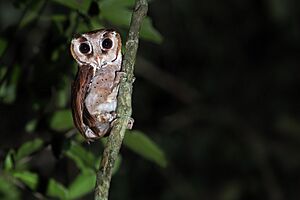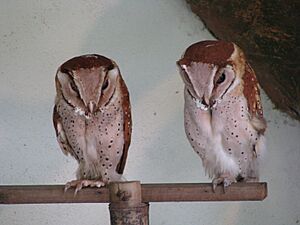Oriental bay owl facts for kids
Quick facts for kids Oriental bay owl |
|
|---|---|
 |
|
| Conservation status | |
| Scientific classification | |
| Genus: |
Phodilus
|
| Species: |
badius
|
| Subspecies | |
|
|
The Oriental bay owl (Phodilus badius) is a unique type of bay owl. These owls are completely nocturnal, meaning they are active and hunt during the night. You can find them across Southeast Asia and in parts of India. They are known for their special heart-shaped face, which has ear-like extensions.
There are several different kinds, or subspecies, of the Oriental bay owl. For a while, the Congo bay owl was thought to be a subspecies of the Oriental bay owl. However, scientists later found that it might not even belong to the same group of owls! The Sri Lanka bay owl was also once considered a subspecies.
Contents
Owl Classification: Subspecies Explained
Scientists group living things into categories. The Oriental bay owl belongs to a group called Phodilus. Within this group, there are different types, called subspecies. These are like slightly different versions of the same animal.
Here are the four main subspecies of the Oriental bay owl that scientists recognize:
- Phodilus badius arixuthus
- Phodilus badius badius
- Phodilus badius parvus
- Phodilus badius saturatus
What Does the Oriental Bay Owl Look Like?
Oriental bay owls are small birds with very distinct features. They have heads that look quite angular. The top and back parts of their bodies are a deep chestnut brown color. Their undersides and stomachs are a creamy, tan color.
These owls have large, striking black eyes. These eyes stand out because of the lighter colors on their faces. Because they are small and often stand upright, they can be very hard to spot in their natural homes.
Owl Sounds and Calls
Oriental bay owls make interesting sounds. They don't just hoot like many other owls. They can also scream and make high-pitched whistling songs. Their songs usually have four to seven sad-sounding whistles. These calls can last from two to eight seconds, and the pitch often gets a little higher at the end. Sometimes, when they move from one place to another, they make a shorter whistle that sounds like kleet-kleet-kleet or kleek-kleek-kleek.
Size and Weight
An Oriental bay owl is typically about 22.5 to 29 centimeters (about 9 to 11.5 inches) long. Their wings can measure between 172 and 237 millimeters (about 6.8 to 9.3 inches). Their tails are usually 168 to 239 millimeters (about 6.6 to 9.4 inches) long. These owls weigh between 255 and 308 grams (about 9 to 10.8 ounces). Female owls are often larger than males in this species.
Where Do Oriental Bay Owls Live?
The Oriental bay owl is found in many places across Asia. You can typically find them in countries like Nepal, Sikkim, Assam, Nagaland, Manipur, Burma (Myanmar), and Thailand. They also live east to southern China, and south through the Malay Peninsula to the Greater Sundas islands.
These owls prefer to live in woodland areas, plantations, and mangrove swamps. They can be found at different heights, up to 2,200 meters (about 7,220 feet) above sea level. This means they are spread out in places like India, Thailand, Singapore, the Philippines, and other parts of Southeast Asia.
Owl Homes and Environment
Not much is known about the Oriental bay owl, even in the places where it lives. They are common in tropical moist forests and in Southeast Asia. You might spot them in tropical wet evergreen forests at high altitudes, sometimes as high as 1,040 to 1,050 meters (about 3,412 to 3,445 feet) above sea level. These sightings are rare.
In India, their homes are in two main areas. One is in the northern Himalayan foothills. The other is in the southern areas, including the southern Western Ghats in Kerala and Tamil Nadu. Some are also found in the wetlands of Sri Lanka. These owls are mostly active at night and tend to stay by themselves.
They usually live at high elevations, from 200 meters (656 feet) up to 2,300 meters (7,546 feet). In the foothills, they stay between 200 and 1,000 meters (656 and 3,281 feet). However, because many forests are being destroyed by humans, some owls now live at higher altitudes, reaching up to 2,300 meters in mountain forests.
Life Cycle and Reproduction
Oriental bay owls are caring parents. Both the male and female owls look after their young. The eggs take about 36 to 42 days to hatch. Almost all the baby owls survive after hatching. The young owls grow quickly and are protected by both parents. The parents are even more protective of the very young chicks, called nestlings, than they are of older chicks.
Nesting and Eggs
Oriental bay owls usually breed in March, April, and May. The eggs are typically laid between March and July. They like to build their nests in hollow tree trunks or any other suitable hole they can find. Sometimes, in Java, they even nest in palm trees.
A female owl usually lays about 3 to 5 eggs at a time. The eggs are white and quite small. They measure about 38 to 40.6 millimeters (about 1.5 to 1.6 inches) long and 30 to 31 millimeters (about 1.2 inches) around. Only the mother owl sits on the eggs to keep them warm, starting two days after they are laid. The father owl hunts and brings food back for the mother and their babies.
What Do Oriental Bay Owls Eat?
Oriental bay owls hunt and eat a variety of small animals. Their diet includes small rodents, bats, small birds, snakes, frogs, lizards, and even magpies. They also eat large insects like beetles, grasshoppers, and spiders.
These owls hunt by waiting on a perch, like a tree branch. Then, they fly through the trees to catch their prey. Their short, rounded wings make it easier for them to hunt, especially near water. Since they live in humid, tropical climates in Southeast Asia and India, they have many food sources and trees to hunt from. When they are caring for their young, the adult owls feed them a mix of rodents, lizards, and frogs.




